Top 10 Patterns from Lake Toho
Top finishers ditched patterns and camped on key spots in Florida
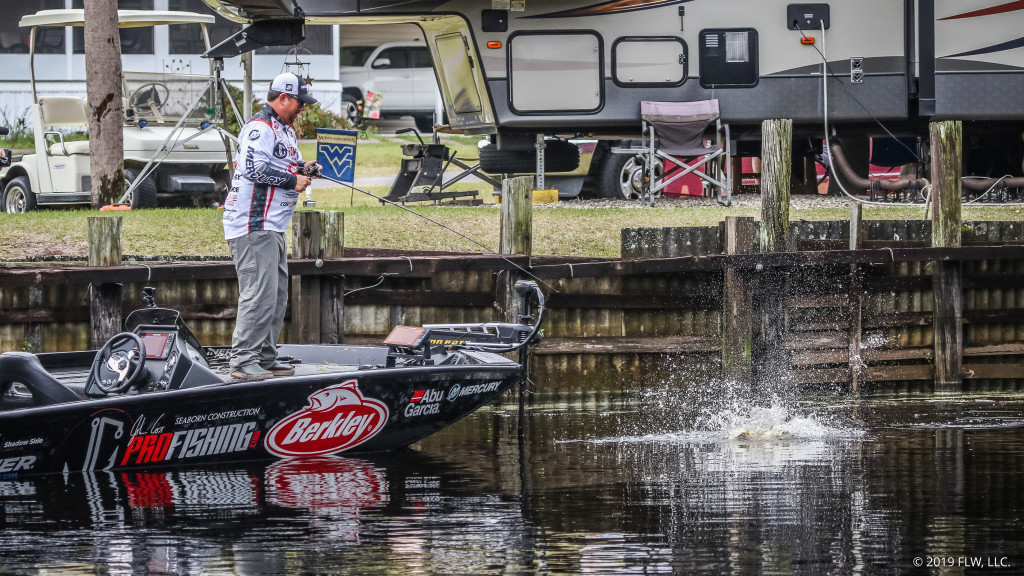
While the Lake Toho FLW Tour event presented by Ranger Boats fell basically right on top of a wave of spawning bass piling into the shallows, many of the top finishers targeted bass that were staging out or transitioning to or from their beds.
Most of the top 10 anglers keyed in on one area or one specific spot for most of the tournament. No one “camped out” quite as well as Chickamauga, Ga., pro Buddy Gross, who earned his second career FLW Tour win on the back of a single spot on Lake Toho. Gross fired a swim jig and swimbait to catch his fish.
Here’s how everyone else in the top 10 did it.
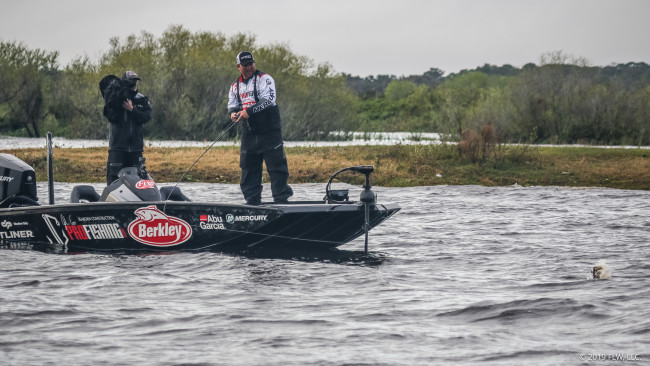
2. Cox goes with the Wind Up, sight-fishes when he can
On day one, it looked like John Cox might run away with this tournament. He weighed in a 31-pound, 9-ounce mega-bag to establish a lead of more than 6 pounds and put himself in terrific position to make a run at another Tour win.
But Florida is never so predictable, and Cox spent most of days two and three scrambling. He weighed in 17-4 on Friday and 8-11 on Saturday.
On Sunday, Cox rebounded with 23-10 to make a strong charge at Gross, but it was too little too late.
Cox did some sight-fishing in Toho on day one using the Berkley PowerBait The General. He had high hopes that several days of warm weather and sunshine would push more fish in to repopulate the shallows, but it just didn’t happen for him. Even on the first day, Cox was forced to back out and throw a watermelon red Berkley PowerBait Wind Up on the outer edge of the grass.
It was the same story on day two. Cox stayed in Toho and just “fished around” with the Wind Up. He finally called an audible on day three by running to Tiger Lake, which is connected to Kissimmee by a narrow, winding creek. Everything looked right in Tiger. There were big fish chasing bluegills, and Cox knew the bass there should be spawning. Yet, for whatever reason, Cox just couldn’t get bit. He barely salvaged the day in Toho and might have had a better option if he’d remembered to bring some lipless crankbaits – or anything to throw on his favorite shell beds in Kissimmee.
“I was so mad at myself,” he says. “When I got in there to where I was fishing, it was in the back of my mind the whole time. I was like, ‘Gosh, you could fish those bars and catch 20 pounds right now.’”
Cox did fish the shell bars on day four, and he did it with an untested bait presentation.
“Today [Sunday] was crazy,” Cox says. “I decided to run straight to the locks and go down. And I started jumping from one shell bar to the next. I hit one shell bar and caught two. Then I caught a good one in like 10 feet of water and was pretty pumped. I caught it on the Wind Up. I put the Wind Up on a Dirty Jigs [Pivot Point Football Jig] head, launched that sucker out there and was just cranking it. I knew the thing ought to work, but I haven’t really gotten to test it much. It was like, thunk. It was a good one. That one was about 6.”
Cox continued to improve his weight by bouncing around through some docks and canals within the system connecting the Harris Chain of Lakes. He got a big boost midway through the final day when he plucked an 8-pounder off a bed on the first cast.
The Wind Up produced another 3- and 4-pounder to round out a solid final day and get Cox into the runner-up position. The new worm from Berkley was his primary bait all week. He rigged it with a 5/0 Berkley Fusion19 EWG hook either weightless or with a 1/16-ounce weight.
“I’d reel it, and where I thought the bites were going to be I’d stop it,” Cox says. “I fished anything that looked like it might have a fish – any turn or hole or wherever I’d think a fish was. I’d reel it really fast to get their attention, and then I’d kill it in the strike zone.”
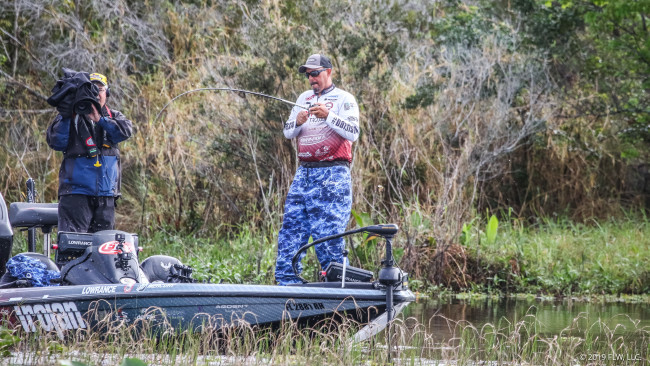
3. Davis stays in Tiger, targets spawners
It was a week of steady improvement for Darrell Davis, right up until the day it mattered most. He brought in limits of 14-5, 20-14 and 25-12 the first three days and only 17-8 on Sunday.
Unfortunately, there’s a little extra sting in this one for Davis after he backed up a 6-pounder and 4-pounder the final day with a rash of lost fish.
“It was one of those days,” he says. “I had the fish to win. I’m not mad, because all I had to do was catch them. But I didn’t.”
Davis spent all four days in Tiger Lake. It’s a lake he’s fished a lot in the past, and he targeted several hard-bottom areas in the lake that he knows are perfect for spawning.
“The hard bottom in each section of that lake is a different kind of hard bottom,” he says. “One section of that lake is hard grass bottom. One section of that lake has the arrowheads – mother-in-law tongues. One section of that lake has reeds and pads with a hard bottom. When you go there, you have to do different things.”
Days one and two were calm, but wind direction dictated which section of the lake Davis fished on the weekend. Generally, he tried to stay out of the gusts. Due to its compact size, Tiger can’t take much fishing pressure, and Davis shared it with a few other anglers on the qualifying days. That also meant he had to keep one of his primary weapons – a Reaction Innovations Trixie Shark – in its holster much of the time.
He fished the two-legged topwater (shiner color) on a 5/0 Gamakatsu EWG hook with a Reaction Innovations Screwed Up Bullet and 50-pound-test braided line with two 7-4, heavy rods from Denali – the Kovert and the AttaX Series.
“The key is getting it up fast and burning it all the way to the boat,” Davis says. “I had three or four fish hit it 5 feet from the boat.
“If you get one waking it you can kill it,” he adds. “If they wake it more than 5 feet, and they don’t eat it, I pause it. Even if it takes 30 seconds I’ll wait because you’ll see the wake go down and the fish is there looking at it. Just watch the line and all the sudden you’ll see it tick, and I just let them swim off with it and catch ’em. The bigger fish will do that sometimes when they’re spawning.”
Davis’ other presentation was flipping a Reaction Innovations Sweet Beaver (junebug) with a 3/8-ounce tungsten weight.
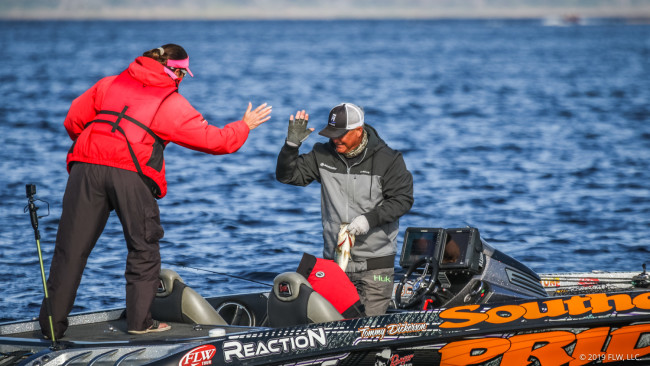
4. Dickerson tosses traps on a shell bed
For a short time on day four, the FLW Liveestimated leaderboard had Tommy Dickerson in first place. His rush to the top came thanks to three big bass, including a 7-5 that Dickerson caught mid-morning. He just didn’t have the kind of weights he needed on days one and two (13-5 and 16-13) to keep up with Gross and company.
Those first two days, Dickerson couldn’t get bit fishing offshore, so he resorted to flipping a Reaction Innovations Kinky Beaver (black and blue) with 80-pound-test braid and a 3/4-ounce weight around small pads up shallow. At about 1 o’clock on Friday, he went to what turned out to be his juice – a shell bed on the main lake in Toho – and caught a 6-pounder. He basically never left that area again.
“It’s just a shell bed in there, and they pull up there and feed for about 45 minutes to an hour every morning,” Dickerson says. “They reposition around these big ol’ huge clumps. It’s like a thousand acres of hydrilla, but they’re just big clumps maybe as big as my boat on two sides, and the shell bed was right in between those two clumps. You had to line up perfectly to throw that trap and follow it down through there. The shell bed was probably 40 by 40.”
Dickerson tried to expand on the area and covered a couple miles of hydrilla, but the only place he could get bit was on the shells. He tossed a SPRO Aruku Shad 75 in gold with black back.
“That’s been my favorite color on Sam Rayburn for years on cloudy days only, but on cloudy days I’ve won a lot of money with it,” Dickerson says. “When I found out the third day was going to be a little bit cloudy, with a little bit of wind, that was the ticket.”
Dickerson might owe a little bit of his success to Deana Hilenbrant, his marshal on days three and four. Hilenbrant predicted the exact cast when Dickerson caught two of his better fish on Saturday and three of them on Sunday. She was such a force of good luck that when a cameraman for the FLW Liveshow wanted to board Dickerson’s boat, the pro said the only way he’d let him on was if Hilenbrant stayed, too.

5. Kissimmee carries Douglas to top 10
Minnesota pro Josh Douglas was one of many top finishers who relied on one area to earn a payday. He spent each day in a spawning bay on the south side of Kissimmee.
“It’s got a lot of pads and arrowheads up by the bank, and then it’s got hydrilla and some isolated pads out in front of it,” he says. “I didn’t hit the bank too much. The only thing I caught off the bank was really, really small ones. I’m sure there are some big ones in there, but it’s just a lot more to pick apart. I fished the hydrilla heavy and the pads that were off the bank a little more.”
Depending on what he was casting to and how aggressive the fish were each day, Douglas leaned on a trio of baits. One was a Z-Man/Evergreen ChatterBait Jack Hammerwith a Gambler Little EZswimbait trailer, which he fished in the hydrilla. That was his primary bait on day three. He fished it with a Shimano Exprideglass rod, a Shimano Curado reel and 17-pound-test fluorocarbon.
He also tossed a BioSpawn ExoStick (black and blue) and a Zoom Ultravibe Speed Worm(junebug) on Texas rigs with a G. Loomis flipping stick, a Shimano Curado(8.5:1), a 1/4-ounce WOO! Tungsten sinker, an Owner Jungle Flippin’ Hookand 50-pound-test PowerPro Super8Slick V2 braid with a 25-pound-test fluorocarbon leader.
Douglas pitched the ExoStick to targets, but also worked in a different presentation with the Speed Worm.
“They like Devil’s Horses and stuff like that here a lot, so I’d kind of throw it past the pads and reel it on the surface like a buzzbait until it got right where I could drop it into the roots. Then I’d just kill it. It’s a big heavy bait, and the big girls just didn’t like it at all.”

6. Strelic hunts hydrilla in Kissimmee
Californian Wade Strelic also banked on Kissimmee.
“I just went looking for hydrilla,” he says. “There’s not a lot of hydrilla down there. It’s only in small areas, which I think is better, because the fish really key in on the hydrilla. Lake Toho has miles and miles and miles of hydrilla, so it’s really hard to locate them in that stuff.”
Strelic fished a large spawning bay in the North Cove area for most of the first two days. It was crowded with boats, but he still caught 21-4 and 13-2. Later in the tournament he moved to another area to finish out with 22-13 and 14-1.
Strelic either burned a 3/8-ounce black-and-blue Z-Man/Evergreen ChatterBait Jack Hammer with a Yamamoto Zako trailer or slowed way down with a junebug Zoom Magnum Ultravibe Speed Worm.
“It seems like the big ones wanted it real slow, almost ticking the grass. I was almost fishing it like a stick bait, or dragging it like a Carolina rig between clumps of hydrilla,” he says. “I didn’t Texas-rig it. I was throwing it on a weighted swimbait hook – a 6/0 swimbait hook on 20-pound fluorocarbon with a 3/16-ounce belly weight. It went through the grass a little better, and it had more of a horizontal profile. It seemed like with a Texas rig the weight would cause it to fall nose-down and hang in the grass a little more.”
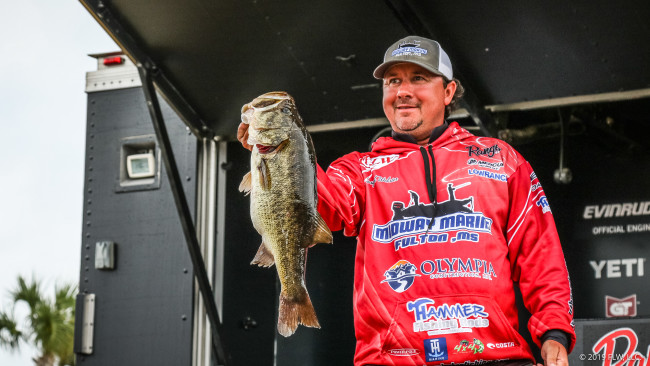
7. Webster splits time between Toho schoolers, Kissimmee spawners
With an early boat draw on day one, Joseph Webster ran to Kissimmee and spent the entire day there. He stayed in Toho on day two to catch a limit of schoolers before running down to Kissimmee, then stuck with the two-lake game plan the rest of the tournament.
The schooling spot was on fire each day.
“It was the mouth of a little old boat lane,” he says. “It had some shells out in front of it. They were schooling – just boiling up. Out of 50 casts I’d probably catch 25. I was throwing a 1/2-ounce [XCalibur] One Knocker. I’d just throw it in there and not just reel it; I’d kind of pump it.”
Down in Kissimmee, Webster fished a junebug Zoom Ultravibe Speed Worm with a 3/16-ounce weight and a 5/0 superline EWG hook.
“I was reeling it really slow. I was trying to keep it down about 2 feet. If it got hung on a little something I’d pop it out, and that’s when they’d usually get it,” he says.
Webster’s Kissimmee spot was a bay situated inside some pads and protected from the north wind. He fished hydrilla and eelgrass in the bay before sliding up into the pads where the bass were moving in to spawn.
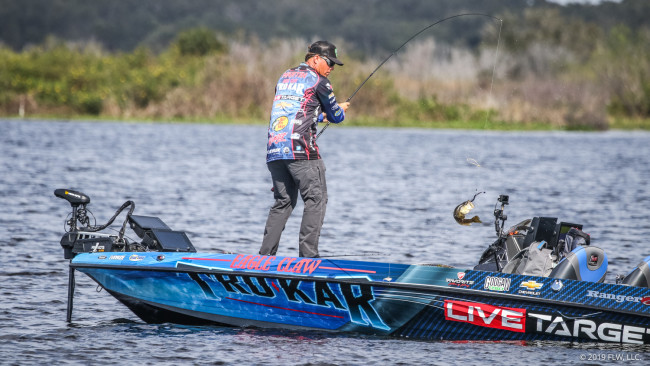
8. Martin sight-fishes in Toho on day one, then rolls to Kissimmee
Scott Martin started off strong with a 24-12 limit from Lake Toho.
“I only had some sight fish on Toho,” he says. “I didn’t have any of what I call ‘fishing fish,’ and that was the problem. I knew with the weather the way it was going to shape up that I couldn’t win it sight-fishing.”
Martin caught a bass that weighed nearly 9 pounds that day – a bonus fish – as well as some good ones on beds, but he never fished Toho the rest of the week. Instead, he ran down to Kissimmee.
“I feel good on Kissimmee. It fishes a lot like Okeechobee,” Martin says. “I knew if I could find an area where they were spawning in the pads to myself I could have a shot at pulling it off.”
Martin keyed in on hard-bottom areas, which he checked by poking his rod down in the water, and areas with decent water clarity. Finding the latter got more difficult over the weekend due to heavy winds. His strategy was to fish quickly through an area until he caught some buck bass, then slow down and work the spot more methodically for some bigger fish.
He just wasn’t able to locate the kind of big bass he enjoyed the first day and slid down the ranks into eighth.
Martin used a squad of baits throughout the week. On day one, he fished a Googan Baits Slim Shake (watermelon red and junebug), which he Texas-rigged with a 1/4-ounce tungsten weight, 5/0 Trokar TK130 hook and 17-pound-test P-Line Tactical Fluorocarbon. He also used a Zoom Fluke (watermelon) on a 4/0 Trokar EWG hook and 15-pound-test P-Line Tactical. Both were fished on a 7-3, heavy Favorite Rush rod.
On day two, he fished the Slim Shake again and added in a lipless crankbait, which he fished on a 7-8 Favorite Phantom. Martin threw a swimming worm on day three. He flipped on the final day using a Googan Baits Bandito Bug (black and blue) with a 1/2-ounce tungsten weight, 50-pound-test P-Line XTCB 8 Braid and a 7-6, heavy Favorite Balance flipping stick.

9. Britt finds magic spot in Toho
Aaron Britt expected to spend most of his tournament in Kissimmee, but save for a couple partial days down there, he made his run at the win via an area near the lock on the south side of Lake Toho. He figured out how good it was while waiting for the lock on day one.
“It’s a big, big flat,” he says. “It’s about 100 yards off the bank from the Kissimmee grass, and you have patches of pepper grass and a lot of bare bottom. On the other side you have basically hydrilla that grows off the bottom about 2 1/2 to 3 feet. We’re sitting in 6 feet of water, so it’s just a perfect zone to wind a trap or any kind of moving bait.”
Britt fished a 6th Sense QUAKE THUD 70 (gold) with a steady retrieve. When he did slow down to fish the grass, he Texas-rigged either a 6-inch X Zone True Center Stick (black and blue) or a Zoom Magnum Trick Worm (junebug) with a 1/4-ounce Wicked Weights tungsten weight.
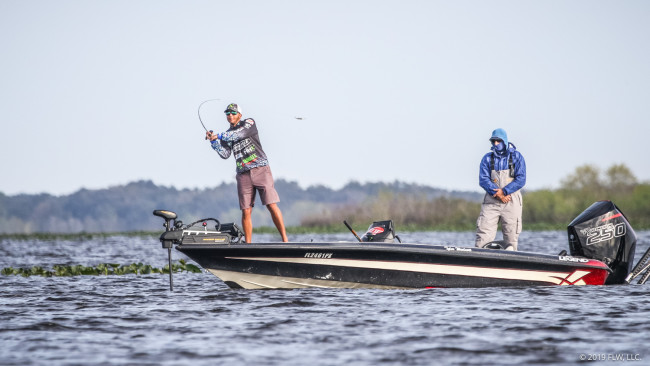
10. Woolcott stays south in Kissimmee
On the first day, once Tyler Woolcott realized only the smaller fish were set up in pads on the south end of Kissimmee, he was able to adjust and get on the right track of some better quality bass.
Woolcott figured out the bigger fish were staging in the hydrilla near the pads he was fishing.
“There’s a lot of hydrilla in there and perfect scattered pads,” he adds. “They kind of stage in the hydrilla, and if they want to go spawn they have perfect pads to spawn.”
Woolcott caught his fish on a 1/2-ounce Z-Man/Evergreen ChatterBait Jack Hammer (clearwater shad) with a Gambler Little EZ swimbait trailer.